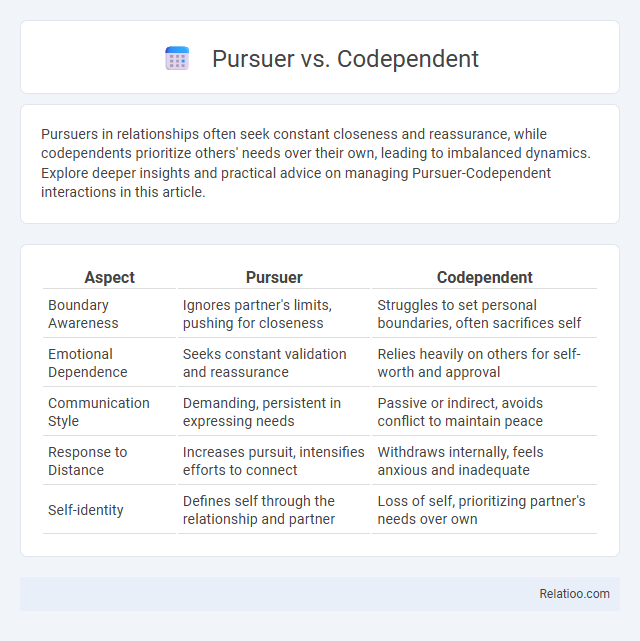Pursuers in relationships often seek constant closeness and reassurance, while codependents prioritize others' needs over their own, leading to imbalanced dynamics. Explore deeper insights and practical advice on managing Pursuer-Codependent interactions in this article.
Table of Comparison
| Aspect | Pursuer | Codependent |
|---|---|---|
| Boundary Awareness | Ignores partner's limits, pushing for closeness | Struggles to set personal boundaries, often sacrifices self |
| Emotional Dependence | Seeks constant validation and reassurance | Relies heavily on others for self-worth and approval |
| Communication Style | Demanding, persistent in expressing needs | Passive or indirect, avoids conflict to maintain peace |
| Response to Distance | Increases pursuit, intensifies efforts to connect | Withdraws internally, feels anxious and inadequate |
| Self-identity | Defines self through the relationship and partner | Loss of self, prioritizing partner's needs over own |
Understanding the Pursuer vs Codependent Dynamic
The Pursuer vs Codependent dynamic revolves around an intense emotional interaction where the Pursuer seeks constant closeness and reassurance, often responding to perceived distance with increased demands for attention. The Codependent partner typically prioritizes the needs of the Pursuer over their own well-being, leading to a cycle of dependency and enmeshment that hinders healthy boundaries and self-autonomy. Understanding this dynamic is crucial for recognizing patterns of imbalance and fostering emotional independence and mutual respect in relationships.
Key Traits of a Pursuer in Relationships
Key traits of a pursuer in relationships include a strong desire for closeness and constant reassurance, often leading to persistent efforts to engage with their partner. They may exhibit high emotional expressiveness and sensitivity to perceived distance or withdrawal, which drives their need to resolve conflicts quickly. Your challenge as a pursuer is balancing these instincts with allowing space, ensuring healthy boundaries that prevent overwhelming your partner.
Defining Codependency: Core Characteristics
Codependency is defined by an excessive emotional or psychological reliance on a partner, often manifesting through enabling behaviors and a need for approval. Core characteristics include an impaired sense of boundaries, difficulty expressing personal needs, and an overwhelming urge to control or fix others' problems. In the Pursuer vs Codependent dynamic, codependents often seek validation by overly accommodating the pursuer's demands, perpetuating cycles of dependency and imbalance in relationships.
Psychological Roots of Pursuer and Codependent Roles
The psychological roots of pursuers often stem from a deep fear of abandonment and a learned hypervigilance to perceived relationship threats, driving their need for control and constant reassurance. Codependents typically develop their roles from early family dynamics characterized by neglect or inconsistent emotional availability, leading to self-worth being tied to caretaking and approval of others. Both roles are perpetuated by unresolved attachment wounds and maladaptive coping mechanisms that maintain unhealthy relational patterns.
Common Patterns in Pursuer-Codependent Relationships
Common patterns in pursuer-codependent relationships include constant chasing for validation and emotional closeness from the pursuer while the codependent partner tends to withdraw to avoid overwhelm. This push-pull dynamic creates cycles of tension where your efforts to maintain connection may lead to frustration and emotional fatigue. Understanding these repetitive behaviors is essential for breaking unhealthy loops and fostering balanced intimacy.
Emotional Needs: Pursuer vs Codependent
Pursuers seek validation and reassurance to alleviate anxiety and feel secure in relationships, often expressing emotional needs overtly. Codependents prioritize others' needs above their own, suppressing their emotions to maintain connection and avoid conflict. Understanding your emotional needs can help balance these dynamics for healthier relationship boundaries.
Communication Styles and Conflict Resolution
Pursuers initiate communication assertively, seeking closeness and quick resolution, while codependents often avoid direct confrontation to maintain harmony, leading to emotional withdrawal. Your interactions may become strained as pursuers demand clarity and codependents prioritize peace, resulting in unresolved conflicts and misunderstandings. Recognizing these differing communication styles enables more effective conflict resolution by encouraging open dialogue and balanced emotional expression.
Impact on Personal Growth and Self-Esteem
The dynamic between a Pursuer and a Codependent often hinders personal growth by creating dependency patterns that diminish autonomy and self-worth. You may find your self-esteem undermined as the Pursuer's need for control and the Codependent's desire to please blur individual boundaries, stalling emotional development. Breaking this cycle is crucial to foster self-confidence and achieve genuine personal growth.
Healing and Breaking the Pursuer-Codependent Cycle
Healing the Pursuer-Codependent cycle requires recognizing patterns of emotional dependence and setting healthy boundaries to foster autonomy. Effective strategies include increasing emotional awareness, practicing self-soothing techniques, and engaging in open communication to dismantle reactive behaviors. Consistent self-reflection combined with therapy or support groups aids in breaking this dynamic, promoting balanced and interdependent relationships.
Strategies for Building Healthier Relationship Dynamics
Healthy relationship dynamics between pursuers and codependents require setting clear boundaries and fostering open communication to reduce anxiety and promote mutual respect. Implementing self-awareness practices helps both parties identify their attachment patterns, encouraging independent emotional regulation and balanced interdependence. Establishing consistent, empathetic dialogue supports trust-building and diminishes unhealthy control or approval-seeking behaviors.

Infographic: Pursuer vs Codependent
 relatioo.com
relatioo.com